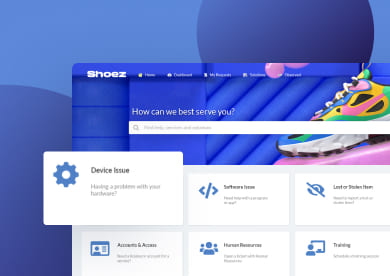Selecting an Asset Management tool that truly fits your organization’s needs isn’t always easy. To make the process smoother, we designed an Asset Management RFP (Request for Proposal) template that gives you a solid starting point for evaluating your options.
This template helps you define your requirements, structure vendor comparisons, and ensure you don’t overlook key factors during the selection process. You can download it for free and use it right away.
What is an Asset Management RFP?
An Asset Management RFP is a document usually created by IT, procurement, or Asset Management teams to clearly outline an organization’s needs and criteria when evaluating Asset Management solutions.
After it is drafted, the document is shared with selected vendors, who then submit their proposals following the defined structure. This process ensures responses can be compared consistently and transparently, giving vendors a clear framework and organizations a reliable way to make informed decisions.
IT Asset Management RFP template download
After years of handling RFPs for organizations worldwide, we have crafted a standardized sample that simplifies the process.
Our comprehensive Asset Management RFP template in Excel is the perfect starting point for those seeking an IT Asset Management solution. And while it’s designed with IT Asset Management in mind, it can also be applied more broadly to Asset Management initiatives. It covers all the essential RFP components (which we’ll break down in the following sections) and helps you save valuable time and effort by structuring requirements clearly for vendor evaluation.
However, keep in mind that this is a structured framework for getting started. You will need to adapt it to your specific needs and goals.
Why is an IT Asset Management RFP important?
An RFP is important because it brings structure and objectivity to the vendor selection process. Whether it’s dedicated to Asset Management or IT Asset Management, an RFP ensures that requirements are clearly defined, proposals are standardized, and decisions are based on comparable criteria.
This not only saves time and reduces risks, but also promotes transparency and fairness when choosing the right solution.
4 benefits of creating a request for proposal for IT Asset Management
Digging a little deeper, defining a formal RFP process will help you with the following:
- Vendor selection: It allows for a competitive bidding process, giving organizations access to various options. You can evaluate the proposals based on predefined criteria, such as functionality, cost, scalability, support, and vendor reputation. This systematic evaluation process helps select the most suitable vendor for the organization's needs.
- Standardization and consistency: It ensures that all vendors receive the right questions and the same set of requirements. This promotes fairness and consistency in the evaluation process, enabling the firm to compare proposals equally.
- Customization and fit-for-purpose solutions: An RFP provides organizations with the opportunity to specify their unique requirements and preferences. Vendors can then propose customized solutions that align with the organization's needs. This enables you to select a solution that closely fits your IT environment, workflows, and business processes.
- Compliance and risk mitigation: By evaluating vendors based on their experience, expertise, and certifications, you can mitigate risks associated with selecting an inexperienced or unreliable vendor. You can also include contractual terms and conditions in the RFP to ensure compliance, security, data privacy, and other Risk Management measures.

Key components of an RFP for IT Asset Management
When preparing an RFP for IT Asset Management, it is essential to include all relevant information to communicate your organization's requirements and expectations effectively.
Downloading the template that we provided you above will help you to start working on it. It covers the key sections to ensure a comprehensive and detailed document:
- Introduction: Provide a brief description of your organization, its objectives, and the purpose of the RFP.
- Project overview: Outline the scope, goals, and specific requirements of the ITAM project, including any unique considerations or challenges.
- Proposal requirements: This section covers all the background information about the vendor, including their company overview, experience, case studies, proposed solution, implementation timeline, and pricing and licensing details.
- Technical requirements: Specify technical aspects such as integration capabilities with existing systems (e.g., LDAP, ITSM tools), support for multiple platforms, mobile access, customization options, extensibility, and security and compliance features.
- Functional requirements: Clearly state the functional capabilities required from the Asset Management solution, including Hardware and Software Asset Management, License Management, Discovery and inventory features, Asset Lifecycle Management, reporting and analytics, integration with procurement and financial systems, and Cloud and Virtual Environment Management.
- Vendor support and services: Outline the expected vendor support and services, including technical support availability and response times, training and documentation offerings, implementation and customization assistance, and regular updates and upgrades.
- Evaluation criteria: Define the evaluation criteria that will be used to assess vendor proposals. This may include compliance with technical and functional requirements, vendor experience and reputation, implementation methodology and timeline, and pricing and TCO.
- Submission details: Provide clear instructions for vendors, including the submission deadline, contact person for inquiries, preferred proposal format (e.g., PDF, Word), and submission method (e.g., email, online portal).
The RFP IT Asset Management plan stages
To design an effective IT Asset Management Request for Proposal, as always, it’s important to have a plan. Here, we outline the different steps involved in it, as well as what and who should be involved in each stage.
1. Internal research
Assemble a dedicated research team, typically composed of technical experts responsible for identifying the internal ITAM needs of the organization and following up the whole process. This team will play a key role in evaluating the existing practices, identifying pain points, and determining the requirements for the new solution.
2. Tool research
The team should conduct a comprehensive search for IT Asset Management tools and vendors that initially appear to address the identified needs – if you need a little help, try with this ITAM tool comparison!
This involves exploring various options, reviewing vendor websites, and seeking recommendations from industry experts or peers. Requesting demos is a great way to see the capabilities and functionalities of the tools in action.
3. RFP template creation
Once the shortlist is established, it's time to create the RFP template. It should incorporate both your organization's specific requirements and the available solutions. This includes designing an evaluation criteria (i.e. allocated budget and key technical capacities).
To do so, you can design a scoring system that will help you compare the vendors in an easy way. For instance, add X amount of points if they cover the basics, and Y and Z if they have some extra useful functionalities.
4. Sending the RFP to vendors
The research team is also responsible for distributing the RFP to the identified vendors, providing them with a clear deadline for submitting their proposals. It is crucial to ensure that all vendors receive the same version of the RFP to maintain fairness and consistency.
Some of them might need to ask you questions to complete the RFP. So, provide a communication channel where they can talk to your team.
5. Evaluation process and final decision
Once the vendors submit their proposals, it is time to evaluate each RFP response based on the predefined standards. Consider factors like cost-effectiveness, feature alignment, vendor experience, scalability, and Total Cost of Ownership (TCO). It can be helpful to use matrices or scoring systems to rank and compare the proposals objectively.
Once you make the final decision, you should also communicate to all the vendors that the selection process is closed, whether you’ve decided to buy their solution or not. Use the same communication channel that you set in the previous stage.
And that’s it! Your buying and implementation processes should soon start after.
Using InvGate Asset Management as your ITAM software

If you’re looking for a solution that goes beyond the basics, InvGate Asset Management is designed to give organizations complete visibility and control over their technology landscape.
It's a no-code platform with an intuitive interface that makes implementation and day-to-day use simple. It’s built to scale with your organization, offering a clear and flexible pricing model so you only pay for what you need.
Here are some of the main capabilities that set it apart:
-
Centralized inventory with multiple population methods (discovery, agent, imports, integrations).
-
Automated tracking of hardware and software with details like usage, costs, warranties, and ownership.
-
Lifecycle management to plan purchases, renewals, recycling, and disposals strategically.
-
Reports and dashboards for automated insights and visual monitoring.
-
Wide integrations with ITSM platforms (including InvGate Service Management), MDM tools like JAMF, remote access tools, and directory services.
Ready to see it in action? Start your free 30-day trial of InvGate Asset Management today and experience how easy Asset Management can be.















